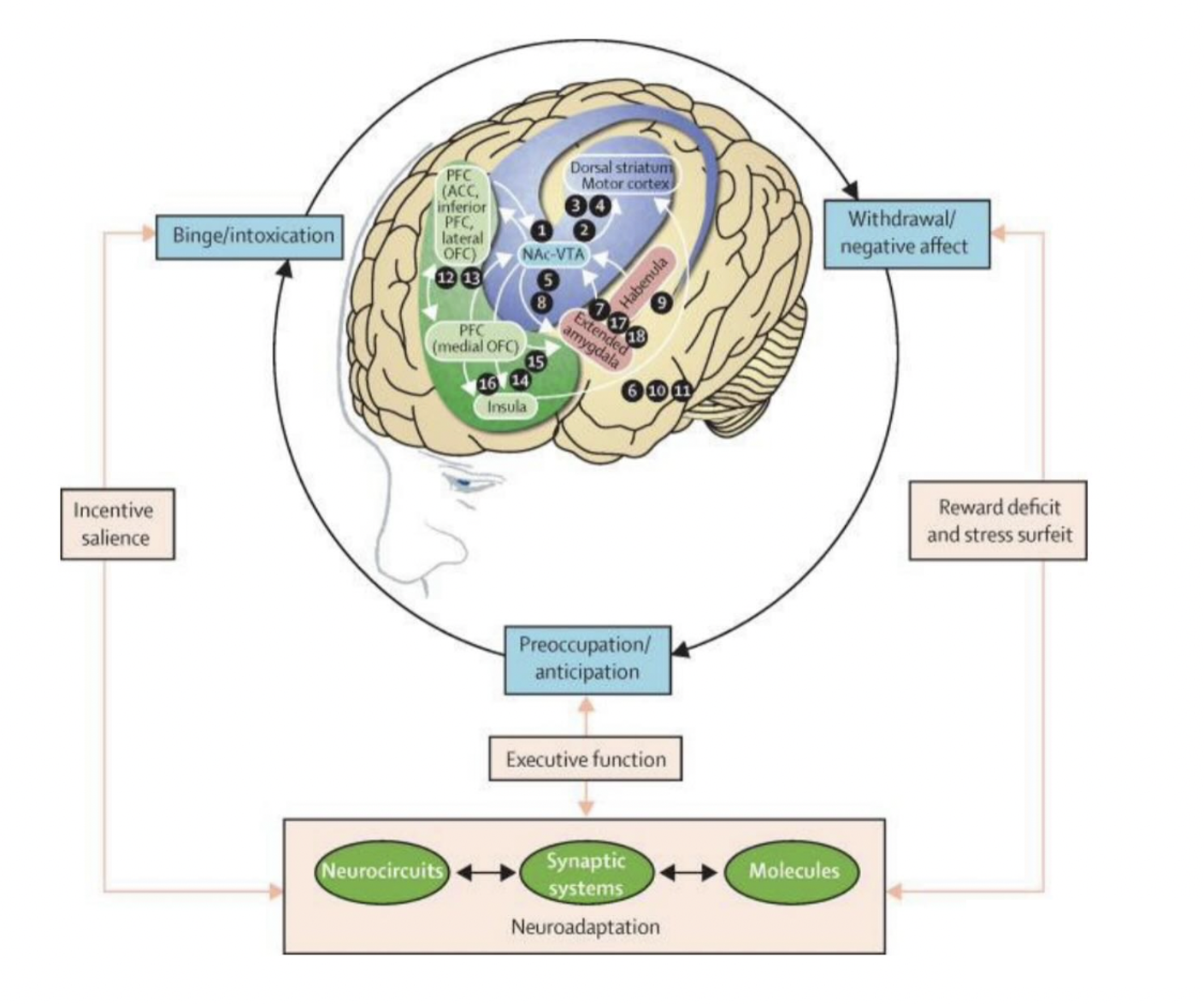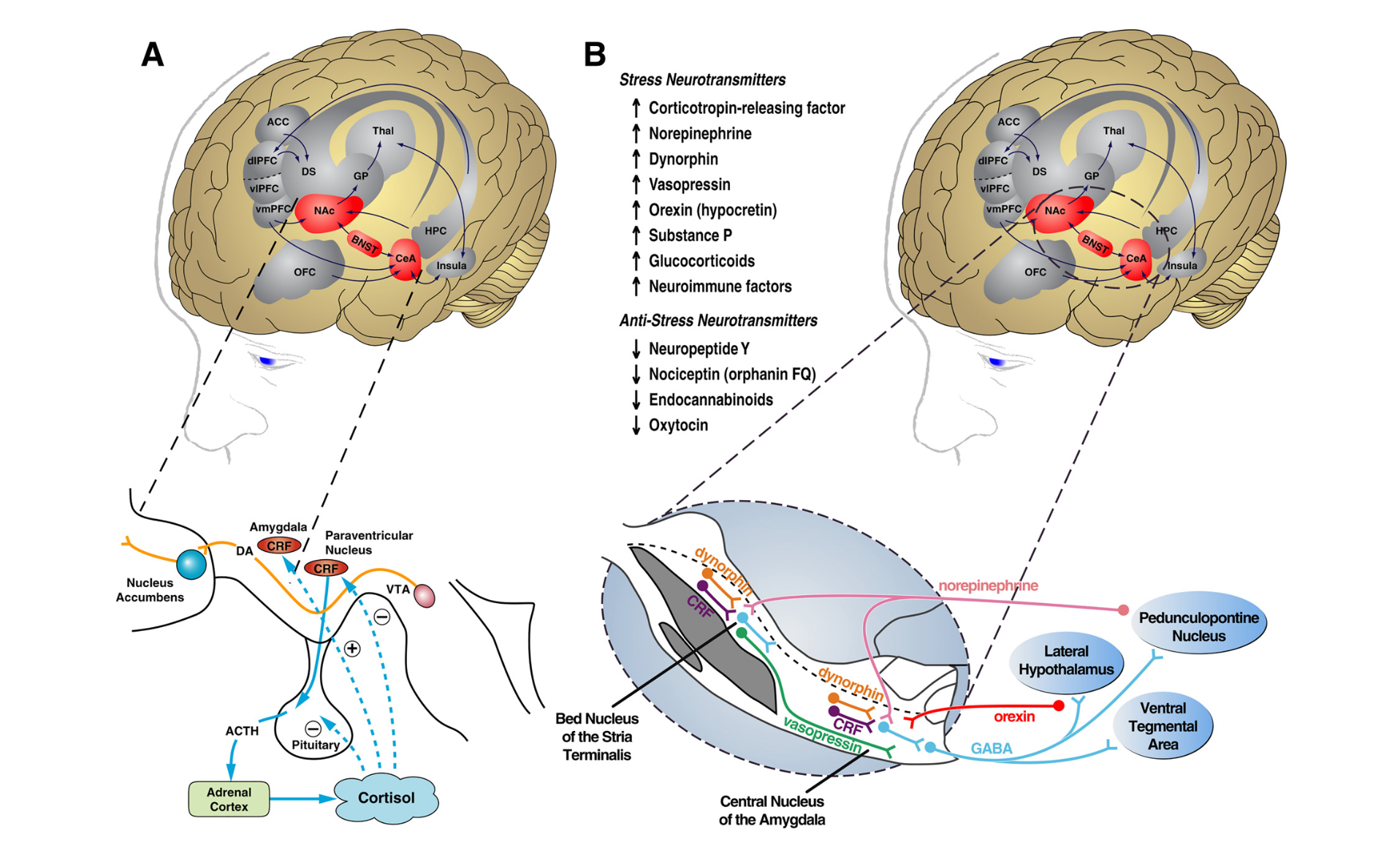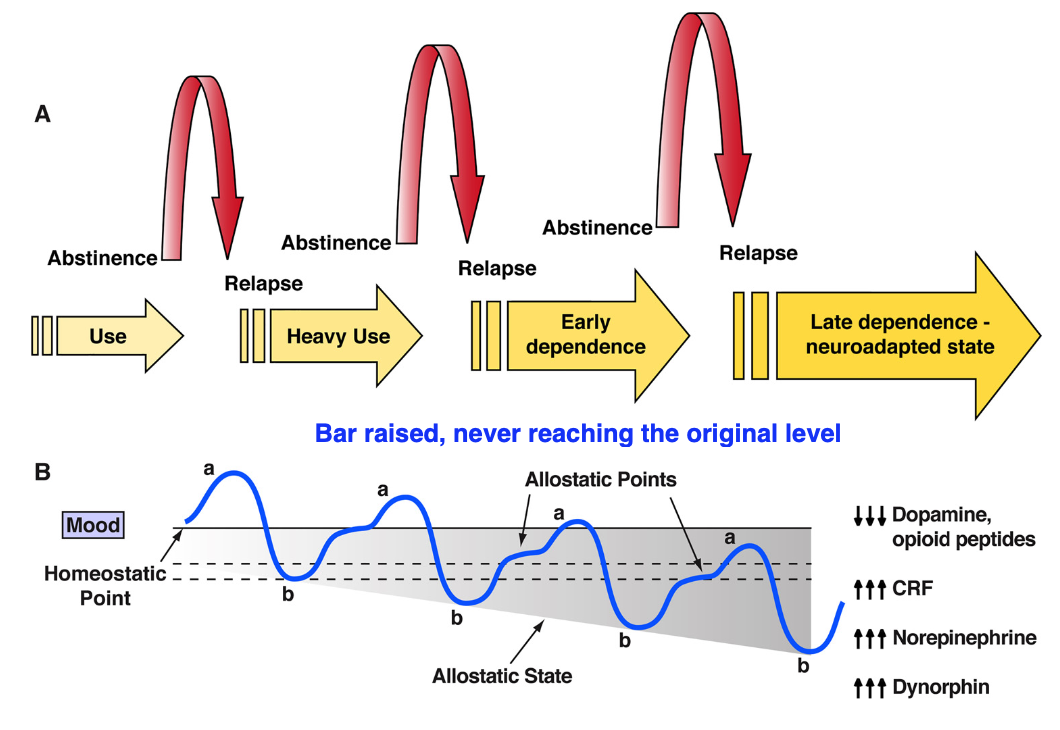Inspiring Brain🧠
Neural Adaptation With Cost: Systematic Balance Distortion

I find addiction's neural circuit as one that is really interesting to look at because it demonstrate a systematic method of adaptation to deviation (sometimes this is quite problematic), an well rounded circular circuit that feeds into each other to achieve the adaptation that has an cost. More importantly, I think it may serve as a model that can help us to understand how adaptation works on a neuronal level, which may effect how we think, feel, and do on the cognitive level, how higher level cognition may stem from basic biological units that continuously reevaluates the needs in the environment and readjust the body's parameter to fit such needs. After reading this, you may have a better intuition of how good cognitive functions really rely on the balance between different circuits that communicates with each others.
Allostatic Processes: Nueral Adapttaion With Cost
I want to discuss the idea of addiction through the perspective of allostasis, which I will intriduce first. Homeostasis, the perspective of deeming how biological system works as a restoration of balance, of an setpoint, may be one that is too ideal to impose to our body sometimes. It assumes a perfect senerio, an egineering system that is imposed onto biology. Allostasis, on the other hand, involves a feed-forward mechanism and describes "stability through chanegs". In the Allostasis hypothesis, the feed-forward allows the matching and adjustment to the environment through continuous reevaluation of needs and continuous readjustment of all parameters toward the new set points. However, when the body is under states that "we don't exactly want to adapt to", the ability to quickly mobilize resources and use feed-forward mechanisms to adapt to the environment can lead to some issues, the cost of neural adaptation.
An allostatic state can be defined as a state of chronic deviation of the regulatory system from its normal (homeostatic) operating level
Koob and Le Moal (2001)
Sometimes the same circuit that help us adapt to an new environent quickly and adjust ourselves may be the same one that leads to allostatic load, allostatic state, or ultimately pathology under extreme conditions. Allostatic mechanims have long being hypothesized to be regulating and maintaining motivational systems that have relevance to the pathology of additction. Using an simile to take home the points:
An acute elevation of blood pressure is “appropriate” in an allostasis model to meet the environmental demand of acute arousal, but chronic blood pressure elevations under conditions of chronic stress may address the chronic environmental demand but is certainly not healthy.
Sterling and Eyer (1988)
The circuit of addiction spans across multiple area and doing multiple things all at once, aligning with the whole theme of "all the area, all the functions, all the state, all at once". Using the conceptual framework layed out in Koob and Schulkin's paper, addiction is mainly separtated to 3 stages: Intoxination, Withdraw Affect, and Preoccupation and each stage have circuits that is specifically for them but also feeding in into other stages. For example:
-
Basal Ganglia (blue structure) is relevant to the Intoxination stage with the activation of various neurotransmitters such as dopamine and opiod peptide, engaging asscoiative mechanism with nucleus accumbens shell, and making an stimulus to response habits engaging the dorsal striatum.
-
In the Withdraw Affect, the extended amygdala (red structures) is highly activated and deviates the balance far from the original set point.
-
Then during the Preoccupation period (green structure) would be relevant to hippocampus and executive function areas like prefrontal cortex + active seacrhing processing areas like orbital and anterior cingulate cortices and temporal lobe.

Conceptual framework of how addiction happens (Koob and Volkow (2016)))
Too Much Reward May Be Chronic Stress
Motivation is a construct that can be defined as “a state that varies with arousal and guides behavior in relationship to changes in the environment. The environment can be external (incentives) or internal (central motive states or drives), and such motivation or motivational states are not constants and vary over time”.
Koob et al. (2010)
Motivation talks about a state with arousal that guides behaviors in the changing environmengt, which have been shown to be correlated with how stress we are. Some levels of stress can be rewarding and benificial for learning as we know that Cortical Releasing Factor (CRF) (think it as stress hormone) may help us to spring to actions, lower the sensory threshold, and have involvement in attentional responses to both external and internal events that increases incentive salience. However, excessive stress would take our body into the vicious cycle and may leads to pathology. The interesting things is that the same circuit that responses to stress have been indicated to have similar effect towards reward, lending the idea that too uch reward may be problematic.
HPA Axis & Glucocorticoid
When we are facing stress, the HPA axis woud be activated and the CRF expressing neurons in the paraventricular nucleus of the hypothalamus would release CRF into the portal system, activates the release of ACTH from the pituitary, which in turn activates the release of glucocorticoids from the adrenal cortex. This is one of the brain's attempt to restore balances as glucocorticoid activation may decrease CRF gene expression, which leads to less CRF. However, this is already a neuroadaptations that initiate the allostatic process, one that deviates from the original point (notice that deviation is perfectly normal as we need to adapt to changes, but a systematic deviation that causes too great of a magnitude shift may be causing some issues).
Back to addiction, drug (reward) would initiates similar effect that stimulate the HPA Axis with ACTH release and establishing the whole down stream effect that can be caused with mild stress described above. In some sense, it seems like stress and reward does both trigger similar activations that causes the reduction in CRH, which makes us feel good. However, the difference being the amount of neurotransmitter that is released. In the drug's case, it has ahuge magnitute (in some sense it is signaling the brain that the person is under chronic stress whne they are actually under euphoria caused by drugs), which links to issues that will be expanded more below.

CRF Circuit (Koob and Schulkin (2019))
Withdraw Affect: Residual Hysteresis
The massive release of reward neurotransmitters (causing the downstream effect mentioned previously) comes with drug-opposite responses as the drug wears off. Because of the magnitute of neurotransmitter release, such opponent processes have been hypothesized to occur even with a single injection of a drug. If the intake is persistant, the brain attempts to keep adapting to the new state and the bar with feeling rewarding would be elevated and may never returns to baseline levels hypothesized by residual hysteresis. progressively, it creats greater elevation of the baseline reward thresholds and leading to more compulsize drug seeking behavior (addiction). Remanber that CRH may boost our learning because it have involvement in attentional responses to both external and internal events that increases incentive salience? Well, the same phenomenon would occur for drugs, the attentional salience map for this object (drug) wouuld be elevated with the "value" of such object over-estimated, hence, amking it even harder to withdraw from it.

Systematic decitation from setpoint (Koob and Schulkin (2019))
The Withdraw stage's effect may feed back into the Intoxination stage since such massive release of neurotransmitter from drug's effect are associated with adaptations such as decreases in dopaminergic transmission and dopaminergic neuron firing in the ventral striatum, nucleus accumbens, and ventral tagemental area, causing the lack of dopamine signal when needed. As well known, dopamine is an key neural transmitter in encoding reward signal, so if there exist a adaptation of systematic deviation, issues would occur as this adaptation is somewhat also raising the bar of feeling reward becuase the body thinks that not as much dopamine is really needed because of the new given condition. Similraly, molecular adaptation with G-protein functioning and protein kinase A activity in the nucleus accumbens also occurs to consolidate these changes that occurs between-systems.
Preoccupation: PFC Being Offline
The Preprontal cortex is usually deemed as a key for executive function and coognitive decision making (i.e. smart choices of not doing drugs). The activation of the HPA axis and the CRF system would negatively impacts the prefrontal cortex to impair such top-down connectivity and boost allostatic changes in the extended amygdala. Now there is a decrease in the inhibitory function of the prefrontal cortex (ventromedial prefrontal cortex, orbitofrontal cortex, and cingulate cortex) and a boosting in the extended amygdala, the habitual mode mentioned in the other article would start to occur, leading to further preoccupation of drug stimuli.
Distortion of Balance
Now you may begin to have some intuition of how these 3 stages work independently on its own but also feeding in to each other to create such trap of addiction and also how systematic deviatoon from the balance point may introduce really serious issues. On the extreme side of these distortion of balance would be psychopaths where it have been hypothesized that one reaosn that may be behind the lack of emotion of psychopath is because of childhood traumatic events that caused them to seggragate their PFC and extended amygdala for too long, leading to the adaptation of distotred balance and the lack of feeling emotions.